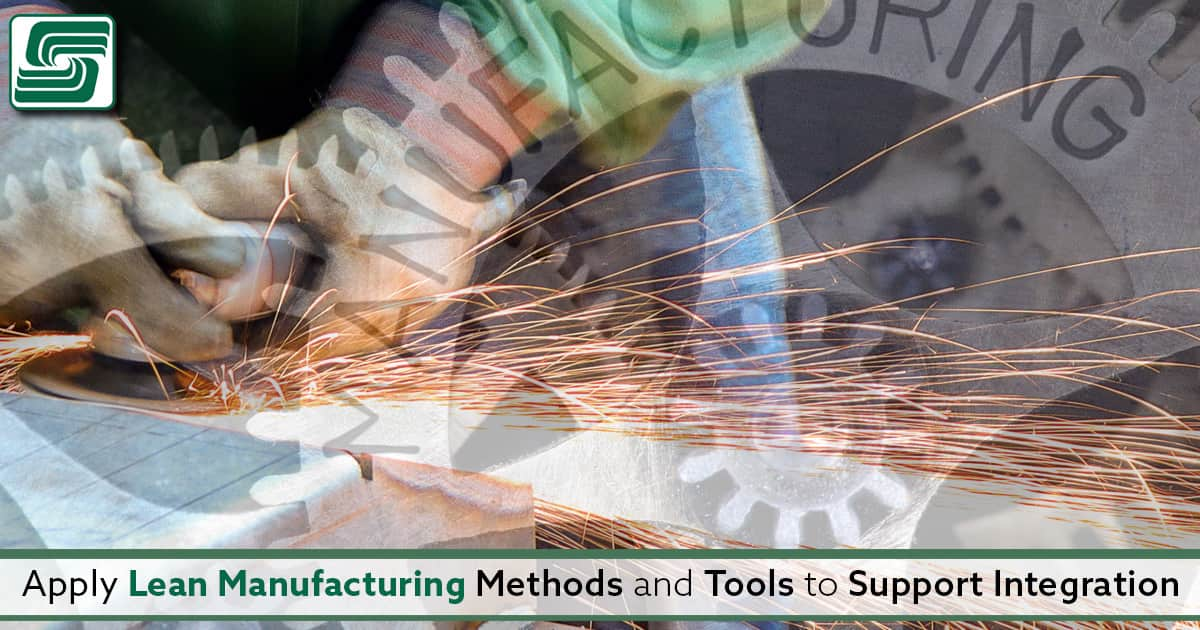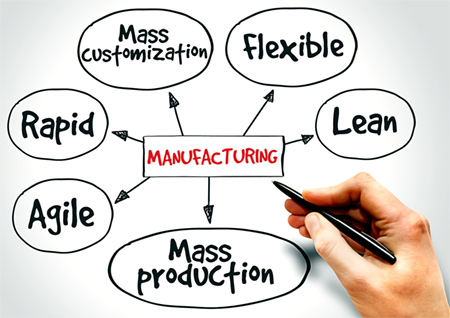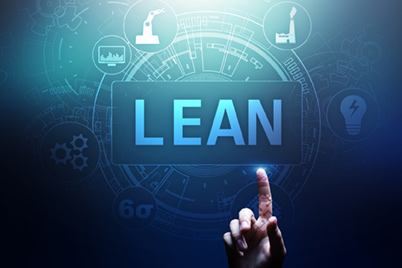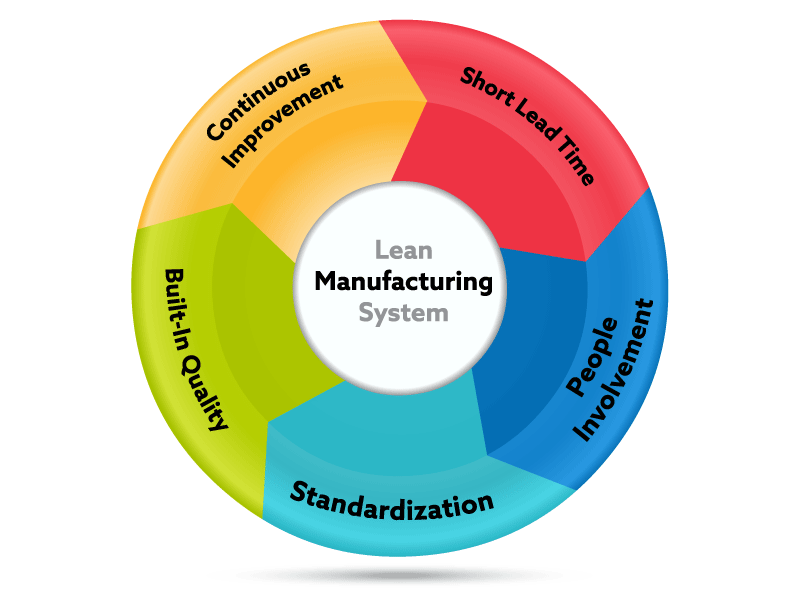
Our previous article shared an overview of what Lean Manufacturing is. Today, we're focusing on Lean Integration.
Maybe you’ve read the previous article, and maybe you haven’t.
Maybe you know that implementing lean manufacturing and a supply chain management system is a smart decision for your business and will help it thrive in today’s market. Maybe, just maybe, you know these things are true, and so you have researched how to make this happen.
Maybe…
However, if the thought of implementing lean integration has left you feeling baffled, then you have come to the right place. The primary focus of this blog post is to help readers understand why Lean integration cannot be treated as a project process but needs to be handled as an ongoing initiative that requires long-term thinking.
Let’s dive in...
Toyota Production System
The Toyota Production System is the impetus for various methods for continuous improvement. Lean borrows and is related to several of these methods. For example:
The theory of lean integration uses those methods as its foundation by using their principle ideas in the integration process. In their book, Lean Integration, An Integration Factory Approach to Business Agility, authors John G. Schmidt and David Lyle define integration:
The practice of making independent applications work together as a cohesive system on an ongoing basis.
Schmidt and Lyle break integration solutions into two categories.
Process Integration: Automation of processes that cut across functional or application boundaries where process state needs to be maintained independently of the underlying application systems or where multiple data consumers or data providers need to be orchestrated as part of a business transaction
Data Integration: accessing data and functions from disparate systems to create a combined and consistent view of core information for use across the organization to improve business decisions and operations.
Think Long-Term Strategy
Lean integration is not a project process. Success requires long-term thinking to handle the manufacturing process and data integration challenges. Deciding on a course of action becomes impossible if you don't have a clearly defined goal.

In their book, Schmidt and Lyle summarize what they say is the most significant value of lean integration.
Lean transforms integration from an art into a science, a repeatable and teachable methodology that shifts the focus from integration as a point-in-time activity to integration as a sustainable activity that enables organizational agility.
Evaluating efficiencies early in the design stage, looking at the value stream, and the whole end-to-end process is essential to the approach. In manufacturing, lean methodology means going from factory to factory, supplier to supplier, and putting together the complete picture of how a product is built and delivered. Viewing the " whole " from the vantage point helps determine where to automate. Automating just one step can often make an entire manufacturing process leaner.
Integrating robotics is one example. Unlike their earlier counterparts, today's robots are multi-taskers that can change tools and perform more than one function at a time—they allow manufacturing more flexibility, reliability, and repeatability than ever before. Machines and devices can exchange information over the Internet without human intervention, connecting the factory floor with the entire organization. Sensors track and gather comprehensive, detailed data throughout the process and even assist with analysis to help determine improvement options.
Chronology of Manufacturing Management Systems
Post World War II saw the development of the global market and increased competition. That competition accelerated methods in manufacturing management thinking and practices. Schmidt and Lyle spotlight the development of 14 major management systems along with eight enabling technologies leading to the development of the Lean Enterprise Management System.
- Eli Whitney: he affected US industrial development by manufacturing muskets with a design including interchangeable parts. This was the first step in mass production systems.
- Industrial engineering was becoming a necessary discipline.
- The father of scientific management, Frederick Winslow, measured production in steel factories, finding the most efficient way of performing specific jobs. Winslow also used time studies for setting daily production quotas.
- Frank Bunker Gilbreth Sr. observed that each bricklayer he watched at construction sites used their own methods of laying brick. He worked to improve practices by eliminating wasted motion and raising production. Frank and his wife, Lillian, developed process charts focusing on all work elements to optimize motion and method.
- Henry Ford and assembly lines
- Statistical process control, developed by Walter Shewhart, became the basis of Six Sigma's statistic models and PDCA problem-solving.
- Total Quality Management was the brainchild of W. Edwards Deming and Joseph Juran.
- Taiichi Ohno developed the Toyota Production System
- Dr. Shigeo Shingo developed just-in-time manufacturing and the Single Minute Exchange of Die. He focused on production and developed the "Defects =0" concept or mistake-proofing.
- One of the seven basic tools of quality management is the fishbone diagram, developed by Kaoru Ishikawa.
- The Toyota Production System has become the most significant manufacturing process advance in decades.
- W. Edwards Deming wrote Out of the Crisis, setting out 14 principles for eliminating variation. He's credited with the idea of Total Quality Management.
- The book Japanese Manufacturing Techniques, written by Richard Schonberger, taught US manufacturers many of the Toyota Production System practices. His book was the start of the US implementing TPS.
- The book, The Machine That Changed the World, written by James Womack and Daniel Jones, was the seed in which lean manufacturing grew.
Striking a Balance
 The methodology used to deliver the lean objective strikes a balance between the organizational culture and technical delivery needs. Many aspects are considered, such as the complexity of the problem(s), the people involved, and the size of the project. Implemented methodologies work best when adaptable to the project, and the general advice is not to get bogged down in details, documentation, and reporting.
The methodology used to deliver the lean objective strikes a balance between the organizational culture and technical delivery needs. Many aspects are considered, such as the complexity of the problem(s), the people involved, and the size of the project. Implemented methodologies work best when adaptable to the project, and the general advice is not to get bogged down in details, documentation, and reporting.
A couple of consistent tips rise when evaluating whether to implement automation in a lean strategy:
- Before investing, test the hypothesis. Model the improvements first and check to be sure they prevent the problem.
- Look for flexibility in automation design features to provide the most exceptional opportunity for making improvements.
Communication technology impacts all areas of the design. Now engineers have broad access to Internet content and the advantage of using and sharing information.
Integration between the factory floor and the rest of the organization effectively implements the latest technologies. Developed countries still hold the advantage in lean methodologies, but emerging countries are catching up. Adaptability and flexibility will be critical to maintaining a competitive edge. Lean is about improvement. If technology is not flexible, development is difficult.
For engineers, that may mean not getting it right the first time around. Lean allows engineers flexibility to modify, adjust, and expand.
Process Engineer Challenges
Implementing a software development methodology can be challenging depending on the project's complexity and the number of people involved. If the method is too light, the results can be unpredictable. A too-heavy methodology risks burying staff in detail, documentation, and reports. Methodologies must allow an organization to breathe, stretch, and bend with the project needs. Process engineers:
- Evaluate and describe the software development methodology.
- Work with project managers to implement the methodology into the software development plan.
- Implement the methodology.
- Assess it and make improvements along the way.
- Provide help in technical risk management.
- Stay on top of software process improvement methods and tools.
Integrated automation is worth the challenge. It supports efficiency across the organization and can even perform remotely, pointing out how valuable the latest advancements in communication technology enhancing integrated automation.
Pressure on manufacturers to be efficient and eliminate waste continues to grow as the manufacturing industry competes in the global marketplace, especially in developed countries. For an increasing number of organizations, applying lean Integration methodologies to automation relieves the pressure by preventing mistakes, providing value for the customer, and allowing for the agility required to remain successful in a highly competitive environment.
Benefits of Lean Integration Include:
- Lower automation costs
- Better use of floor space
- Simpler implementation
- More flexibility for set and material flow
- Operator utilization maximized
- Provision of data for future solutions and continuous improvement.

Other integration approaches have been and still are used. Most focus on the part of the problem or approach problems when they happen. Different integration strategies use customized hand-coded solutions, project-by-project, with no master plan. The results can be a patchwork of solutions that costs more to maintain, it's hard to change. It offers little to no flexibility—leaving an organization continually putting out fires and struggling to play catch-up to the shifts in the environment.
Lean integration is different. lean organizations are agile. They can stay ahead of market shifts, the plethora of regulatory demands, and information technology (IT) complexity. Simply defined, lean Integration is a data-driven methodology that uses metrics to ensure continuous quality and performance.
Lean methodology generates:
- Up to 90% reduction in project lead time
- A 50% gain in the integration of team productivity
- Significant and continuous improvements in project quality
- More cooperation across internal work teams
The focus of lean Integration is to make independent applications work together in an ongoing interconnected system. The integration of technology solutions breaks down into two solution styles: Process Integration and Data Integration. Lean integration is a repeatable, teachable, and agile science, enabling the organization to change rapidly without increasing risk or compromising on quality. Reusable components, enhanced data, metrics designed to drive continuous improvement, innovation facilitated by a fact-based approach, and an engaged IT staff are the glue that holds lean Integration together. Lean manufacturers produce more with fewer employees, less cost, and faster products to market—largely due to advances in computer-aided capabilities and communication technologies.
The result is less waste and more streamlined production, line-allowing long-term advantages for manufacturers. There are many useful tool sets available-the cautionary tale is to pay close attention to the approach to increase the opportunity for success.
In Sum
Apply lean management methodologies and tools to support your lean transformation. If you want to improve, you need to measure what is working and what isn't working.
Find the right balance between project management, automation tool usage, and process improvement methods. Develop a culture that supports and encourages continuous improvement.
Lean management and method can create the foundation for an organization's successful transformation into a more agile organization.
Through strategic implementation, lean integration can provide the agility required to remain successful in the highly competitive manufacturing environment.